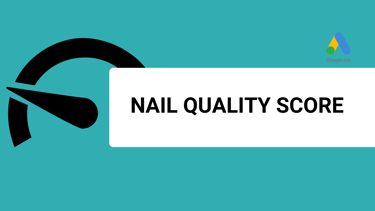Google Ads Quality Score: Boost Ad Performance & Reduce Costs
Learn how to improve your Google Ads Quality Score to reduce CPC and boost ad placement. Expert tips to enhance CTR, ad relevance, and landing page experience.
ADVANCED STRATEGIES
10/5/20246 min read


Have you ever wondered why your Google Ads campaigns aren't driving the results you expect, or why you're paying so much per click?
You’re not alone. Many businesses invest heavily in Google Ads, only to see underwhelming performance.
The hidden factor could be your Google Ads Quality Score—a critical but often overlooked metric that can make or break your campaigns.
In this article, we’ll explore what the Google Ads Quality Score is, why it matters, and how you can optimize it to achieve better ad placement and lower costs.
What is Google Ads Quality Score?
Google Ads Quality Score is a grading system that determines the relevance and quality of your ad campaigns. It’s a score from 1 to 10, with 10 being the best, and it plays a crucial role in how your ads perform on the search engine results page (SERP).
The higher your Quality Score, the better your chances of getting prime ad positions at a lower cost. Essentially, Google uses this score to measure how relevant and useful your ad is to the searcher.
Why Google Ads Quality Score Matters for Your Business
A common frustration among business owners is the high cost of running Google Ads, particularly the Cost Per Click (CPC). Many business owners on platforms like Reddit ask: "Why are my CPCs so high?" One reason could be a low Quality Score. A higher Quality Score can lower your CPC significantly, as it indicates that your ad is more relevant to users.
Instead of focusing on the feature of scoring, think about the benefit: by improving your Quality Score, you not only reduce costs but also increase the likelihood of your ad appearing in top positions. Data suggests that advertisers with a Quality Score of 7 or higher can pay up to 50% less per click compared to those with lower scores.
Key Factors that Affect Your Google Ads Quality Score
There are three key factors that influence your Google Ads Quality Score: Expected Click-Through Rate (CTR), Ad Relevance, and Landing Page Experience. Each plays an essential role in determining how Google views the quality of your ad campaign.
Expected CTR
Expected CTR is Google's estimation of how likely users are to click on your ad. This is based on past performance and the relevance of your ad to the search query. Improving your CTR starts with writing compelling ad copy, targeting the right audience, and continuously testing ad variations. Higher CTR indicates that your ad is resonating with users and fulfilling their search intent, leading to a better Quality Score.
Ad Relevance
Ad relevance measures how closely your ad matches the intent behind the search query. If your ad aligns well with what the user is searching for, you’ll receive a higher score in this area. To ensure relevance, match your keywords with the search intent and avoid clickbait-style ads, which may initially attract clicks but can hurt long-term performance if they aren’t aligned with user expectations.
Landing Page Experience
Google cares about what happens after the user clicks on your ad. The landing page they arrive at should be fast-loading, mobile-friendly, and relevant to the ad itself. A positive landing page experience increases the chances of conversion and boosts your Quality Score. For example, one business significantly improved their Quality Score after revamping their landing page to focus on user experience and mobile optimization, which resulted in a noticeable increase in ad performance.
How to Improve Your Google Ads Quality Score
Now that you understand the key factors, let’s dive into how you can improve your Google Ads Quality Score. Whether you’re working to optimize your CTR, ad relevance, or landing page experience, these actionable tips will help you see results. Improving your Quality Score isn't something to put off—act now before your competition outranks you!
Optimizing Ad Relevance
Start by refining your keyword research. Use tools like Google Keyword Planner to find keywords that are relevant to your product or service and align with searcher intent. Avoid using overly broad or unrelated keywords that could make your ad seem irrelevant to potential customers. Additionally, customize your ad copy to speak directly to different audience segments. Personalization is key to relevance, and a more targeted message can boost your Quality Score.
Boosting Your CTR
To improve CTR, focus on A/B testing your ads. Create different versions of your ad and test them against each other to see which one resonates most with your audience. You can also incorporate emotional triggers like urgency, FOMO (Fear of Missing Out), or scarcity to encourage users to click on your ad. For example, a limited-time offer or highlighting that stock is running low can lead to higher click-through rates.
Enhancing Landing Page Experience
Your landing page experience is a major factor in Quality Score. First, ensure that your landing page loads quickly, as slow load times can cause users to bounce and signal to Google that your page isn’t meeting user expectations. Next, optimize for mobile. More than half of all web traffic comes from mobile devices, so having a mobile-friendly landing page is essential. Finally, make sure that your landing page is directly relevant to the ad—users should find exactly what they were expecting after clicking through.
Common Objections to Improving Google Ads Quality Score and How to Address Them
You might be thinking, “Improving Quality Score sounds time-consuming.” While it does require some effort, the payoff is huge. Small, incremental changes to your ad relevance, CTR, and landing page experience can lead to significant cost savings over time. Another common objection is, “I don’t know where to start.” Begin by focusing on one area—whether it’s ad relevance, landing page experience, or CTR—and take gradual steps to optimize.
Real-World Examples of Businesses that Improved Their Google Ads Quality Score
Let’s look at some real-world examples.
Case Study 1: An e-commerce business managed to cut its CPC costs by 30% after focusing on ad relevance. By aligning their ad copy and keywords more closely with what users were searching for, their Quality Score improved, which led to lower costs and higher ad placements.
Case Study 2: A local service provider improved their landing page experience and saw their Quality Score jump from a 5 to a 7, resulting in a 50% increase in conversions at a much lower CPC.
How Does Quality Score Impact Your Cost Per Click (CPC)?
Quality Score is a crucial factor in determining your CPC. Google calculates CPC based on both your Quality Score and your Ad Rank. A low-scoring ad will cost you more to achieve the same placement as a high-scoring ad. By improving your Quality Score, you can reduce the amount you pay for each click while maintaining or even improving your ad placement.
Google Ads Quality Score vs. Ad Rank: What’s the Difference?
It’s easy to confuse Quality Score and Ad Rank, but they are two separate metrics. Quality Score focuses on the relevance and quality of your ad, while Ad Rank determines your ad’s placement on the SERP. Although they are different, they work together: A high Quality Score boosts your Ad Rank, meaning you get better placement for less cost.
Expert Tips on How to Maintain a High Google Ads Quality Score
Maintaining a high Quality Score requires continuous testing and monitoring. Regularly test new versions of your ad to ensure that your CTR stays high, and make adjustments as needed to improve relevance. Leverage data from your Google Ads and analytics tools to refine your targeting and strategy. Keep a close eye on changes to your Quality Score and be ready to adapt before your competitors catch up.
How Often Should You Review Your Google Ads Quality Score?
It’s important to monitor your Quality Score on a regular basis. Depending on how often you run campaigns, you should check your score at least weekly or monthly. Ignoring this metric could mean losing out on opportunities to reduce your ad costs and improve placement. By making Quality Score part of your regular campaign review, you can stay ahead of the competition and maximize your ROI.
Avoiding Common Mistakes that Lower Your Quality Score
One of the most common mistakes advertisers make is using irrelevant keywords that don’t align with user intent. Another mistake is having slow or poorly optimized landing pages. Users expect your page to load quickly and be easy to navigate on mobile devices. Finally, avoid misleading ad copy, which can reduce ad relevance and hurt your Quality Score.
How to Track and Monitor Your Google Ads Quality Score Over Time
Use tools like Google Ads’ built-in Quality Score metrics or third-party tools to track and monitor your score. A well-maintained analytics dashboard will help you identify which areas need improvement, whether it’s your CTR, ad relevance, or landing page experience. Make sure you act on this data regularly—your competitors might already be optimizing, so don’t wait too long to adjust your campaigns.
Conclusion
Improving your Google Ads Quality Score can dramatically lower your costs and improve your ad performance. If you’ve been struggling to see results from your campaigns, now is the time to take action.
Start by optimizing your ad relevance, boosting your CTR, and enhancing your landing page experience. Don’t wait—your competitors are likely already making improvements.
Take the next step and contact us for a free consultation on how to improve your Google Ads campaigns today.
CONTACTS
incomewithdigitalmarketing@gmail.com
BOOK WITH US
SERVICES
Google Ads Assisstance
Google Analytics Setup
Google My Business Management
